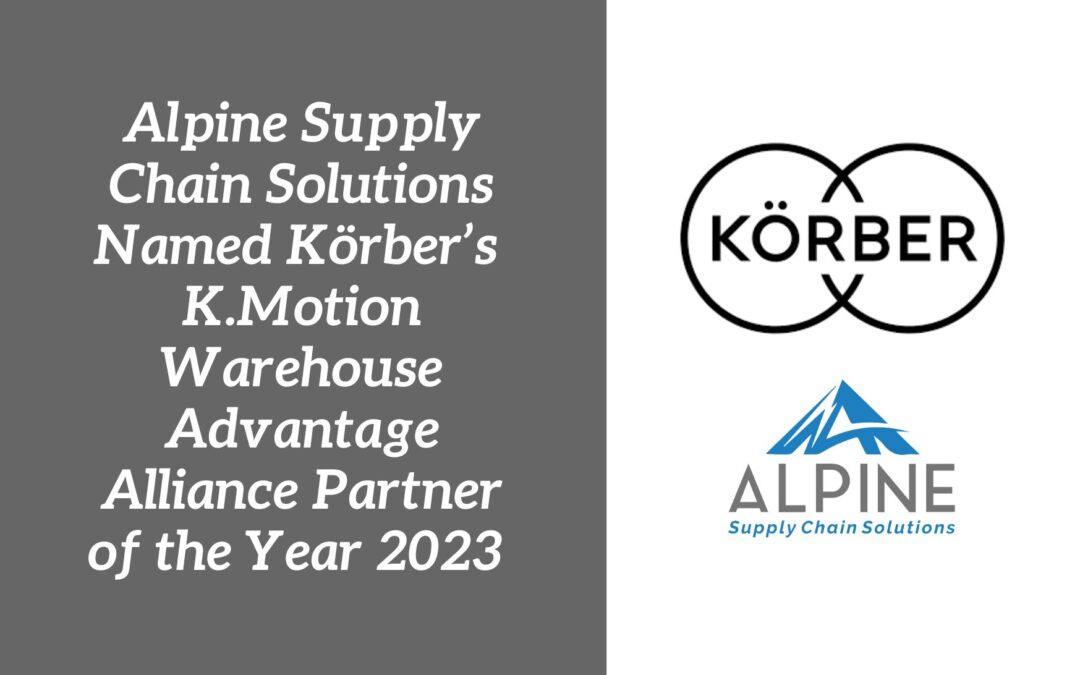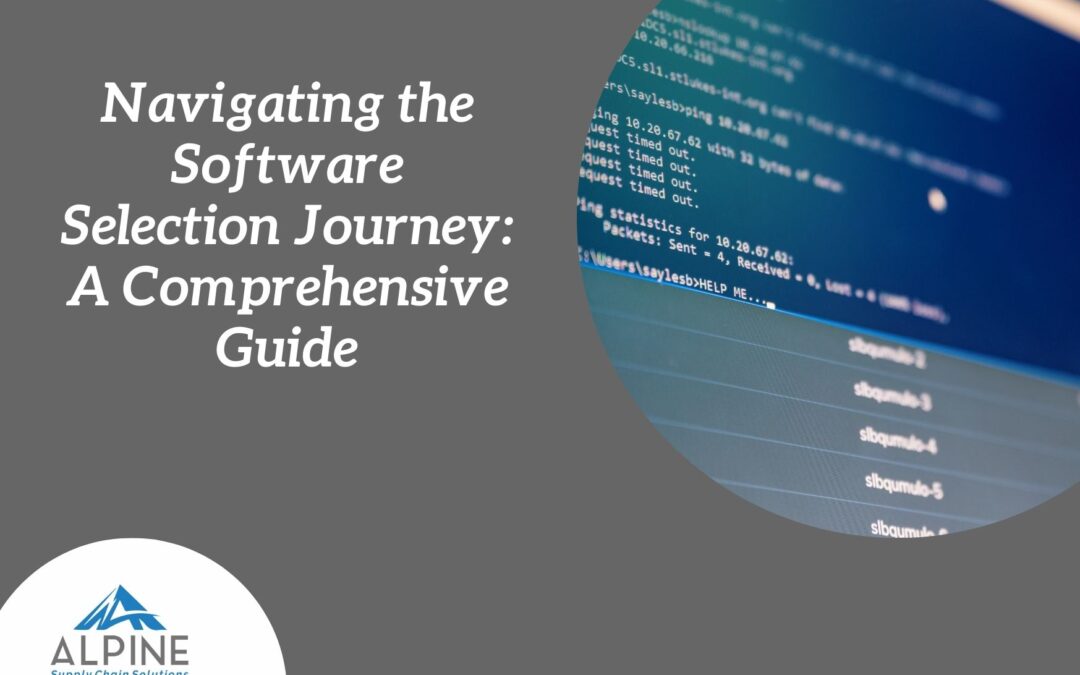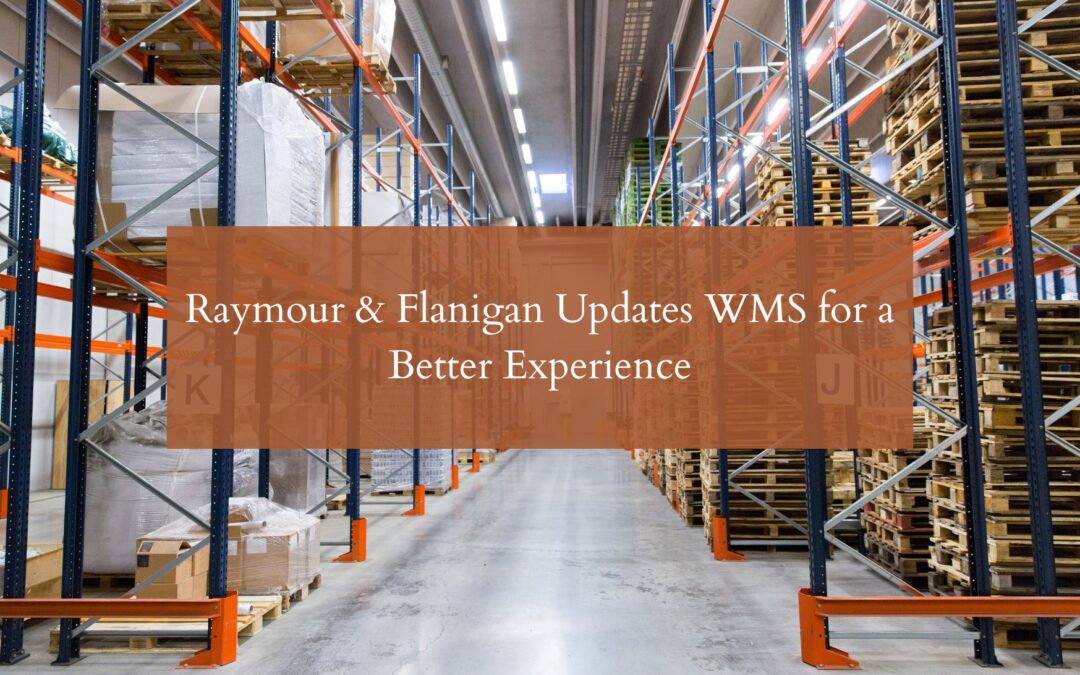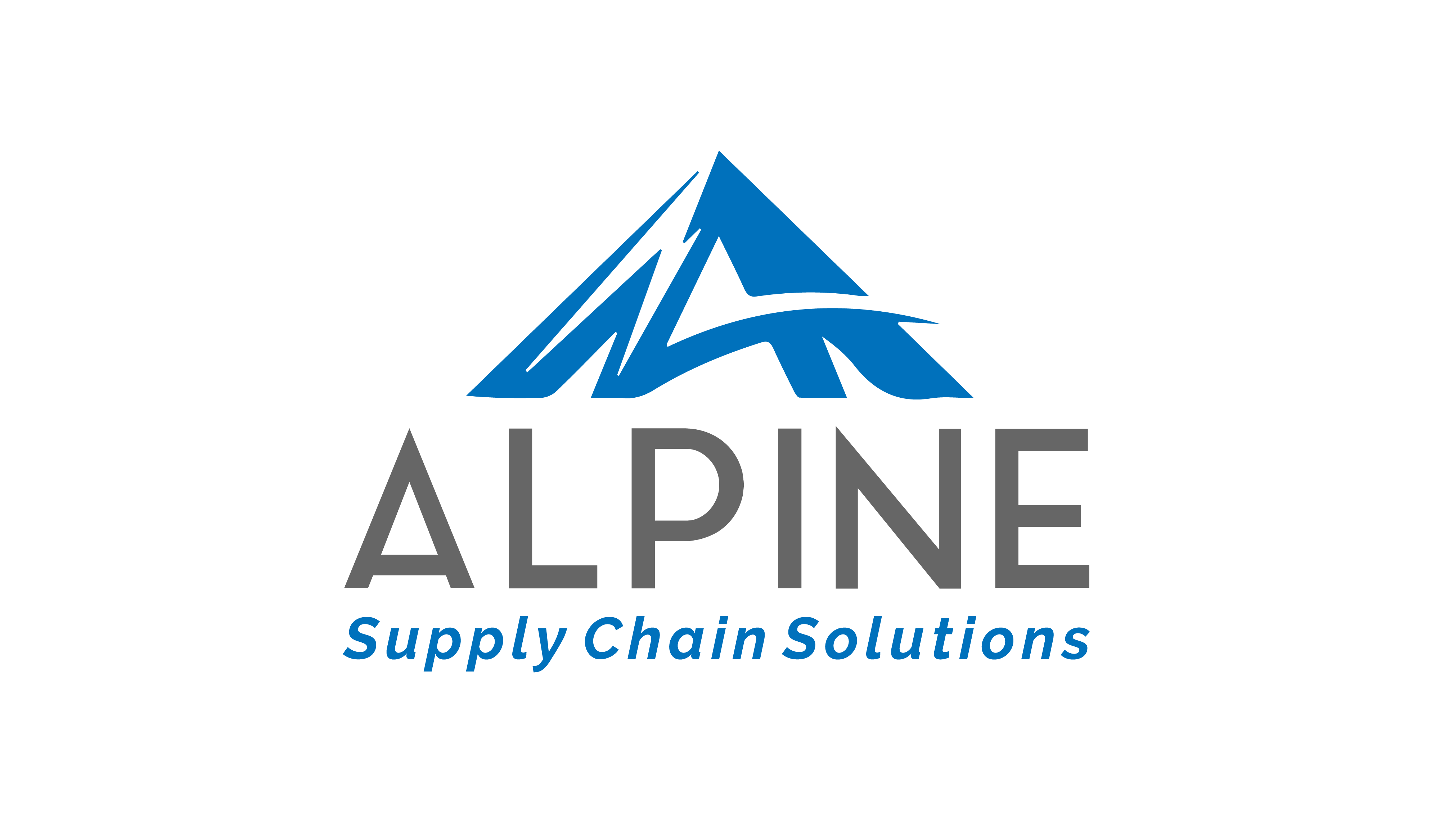
by Noelle Abarelli | Apr 22, 2024 | Alpine News Blog
NAPLES, FL — April 22, 2024 — Alpine Supply Chain Solutions, a boutique consulting company focused on maximizing supply chain investments, is proud to announce they have been named Körber Supply Chain Software’s K.Motion Warehouse Advantage Alliance Partner of the Year for 2023. This award recognizes Körber partners across key sales and customer success categories that align with some of the biggest challenges in the supply chain today. Alpine was selected as the winner of this category based on their engagement in leads, sales, marketing, and their two largest 2023 cosell deals in North America, True Value Company and QVC. The award was presented to Alpine’s Managing Principal, Michael Wohlwend, on the first evening of Körber’s Elevate Americas 2024 event taking place in San Diego, CA on April 21st-24th.
Through a distinctive data-driven methodology and extensive expertise spanning decades, Alpine spearheads operational enhancements within the warehouse, optimizing space, equipment, labor, and control. One of the company’s core focuses is supporting clients with WMS implementations. By synergizing Körber’s top-tier WMS solutions with Alpine’s profound implementation know-how, mutual clients benefit from a robust partnership guaranteeing WMS success.
“We are thrilled to celebrate the exceptional achievements of our 2023 Partner award winners, recognizing their unwavering dedication to sales and customer success,” said Carl DCosta, Global Partner Officer at Körber Supply Chain Software. “Our Partners are there delivering for our customers – understanding customer pain points, finding the right capabilities, offering the right Körber products and implementing them to deliver faster time-to-value”.
2023 marked the inaugural year for Körber’s K.Motion Warehouse Advantage Alliance Partner of the Year 2023. Alpine was recognized as Körber’s Breakthrough Partner of the Year at Elevate Americas 2023. To learn more, visit the conference website.
About Alpine
Alpine Supply Chain Solutions, based in Naples, FL, is a supply chain consulting company driven to ensure their clients get the most value from their investments. Their approach to every project starts with the data and ends with a cost justifiable solution. With deep roots in industrial engineering, Alpine’s approach is unique. For more information, please visit: AlpineSupplyChain.com
About the Körber Business Area Supply Chain
Supply chains are growing more complex by the day. Körber uniquely provides a broad range of proven, end-to-end supply chain solutions fitting any business size, strategy or appetite for growth. Our customers conquer the complexity of the supply chain thanks to our portfolio that includes software, automation, mail and parcel solutions, voice solutions, robotics, and materials handling – plus the expertise to tie it all together. Körber helps to manage the supply chain as a competitive advantage. Conquer supply chain complexity – with Körber. The Business Area Supply Chain is part of the global technology group Körber. To learn more about Körber’s Business Area Supply Chain, visit koerber-supplychain.com.

by Noelle Abarelli | Apr 17, 2024 | Blog
In today’s fast-paced business environment, selecting the right enterprise software can make or break an organization’s success. From streamlining operations to enhancing customer experience, the right solution can drive significant value. However, navigating the software selection journey isn’t simply about finding the most popular solution and implementing it. It requires careful planning, thorough evaluation, and strategic decision-making. In a recent webinar, The Journey: Buying Enterprise Software Effectively, Alpine experts explored all the facets involved in navigating the software selection process. Read the main takeaways below, or watch a recording of the webinar here.
Getting started
Selecting enterprise software effectively is a multi-faceted journey that involves several key steps. It begins with defining clear objectives and requirements, followed by the creation of a Request for Proposal (RFP) to solicit vendor responses. Leadership involvement is crucial at every stage to ensure alignment with organizational goals and objectives. In our experience, project success depends on eight critical factors.
#1 Leadership: Strong leadership is provided by executive management to oversee the project and provide support to the team.
#2 Achieving buy-in: The team should comprise subject matter experts and involve representation from all aspects of the business (e.g. warehouse team, IT group, sales, executive leadership, etc.) to ensure you don’t miscalculate resources, gain buy-in and ensure all requirements are met.
#3 Focus on the goal: The team needs to be focused on the project’s success with no distracting ulterior motives.
#4 Be methodical: Engage in a deliberate, engaged, and thorough process.
#5 Anticipate change: Be prepared to adapt and pivot as needed, large undertakings rarely go off without some surprises.
#6 Invest in due diligence: Fully vet any solution, technology, vendor/integrator references. This involves evaluating not only the software but also the vendor’s operations, culture, technology, and integration capabilities.
- You may be wondering if hosting a traditional demonstration is enough to vet vendors, and we’re here to tell you, it’s not. A traditional vendor demonstration is performed in a vacuum, you’re seeing how their solution works on the best of days when everything is within control and going as planned. It may not show you how the solution works with regard to the specific functionality you are looking for. In some cases, what you want to learn is not necessarily if a vendor performs a certain function, but how they do it so you can determine if it fits in with your processes.
#7 Contracting: Get details on all contracting needs and their structure regarding software and services. It’s critical to discover if the vendor provides everything you need, and what contract limitations may be.
#8 Execution: Ensure you have a strategy in place to handle change management, scope, budget control, and any ongoing needs.
Most importantly, it’s critical to determine what your organization considers a measure of success for the project. All team members must be aligned on this to work toward the same goal.
Why Implementations fail
Unfortunately, around 80% of implementations fail, and it’s not always because of the solution, but rather due to organizational complications. Sometimes it’s because there’s no organizational commitment or the organization sets unrealistic expectations to begin with. Other reasons include:
- The system implementation is viewed as an IT project rather than an organizational one
- The selected vendor is a bad match
- Inadequate education and training of the implementation team and its users
- Inflexibility in adapting to new processes (trying to do things the same way as before with the new software)
- Inaccurate data loaded into the system
And while there are many ways buying enterprise software can go wrong, there are tried and true strategies that can help you navigate the selection process with confidence.
Best Practices
As the software selection journey progresses, there are several best practices and insights to keep in mind.
-
- A structured approach to the selection process is critical, with a focus on thoroughness and avoiding shortcuts. This includes getting a clear understanding of what the business requirements are. This is where real attention to detail is critical, and no item is too small to include.
- The RFP phase requires significant effort to ensure clarity and enable vendors to respond effectively. The list of business requirements will be the foundation of this RFP, and will enable organizations to vet solutions down to every last detail.
- Don’t limit your search to the well-known names. This is a significant investment, so you want to get a complete picture of all that’s available to you. Including up-and-coming vendors in the selection process can help keep established vendors competitive.
- During demonstrations, prioritize scenarios that align with the organization’s most critical needs and push vendors to showcase their capabilities beyond standard demos. If possible, have a list of worst-case scenarios specific to your operation that you can throw into the demo to see how the vendor would respond.
- Technical deep dives with vendors are essential for understanding their product roadmaps, especially regarding cloud-based solutions and ongoing development efforts.
- Don’t rush the selection process. Hosting periodic workshops with the team allows for detailed discussions on cost estimates, project plans, assumptions, and resource requirements. It will also ensure nothing has changed in the plan and that everybody is still working with the same end goal in mind.
- Create a point system that will allow for subjective scoring of each solution presented. Assessing subjective feedback alongside objective scoring helps make well-informed decisions and identify potential gaps in understanding.
Remember, the ROI break-even time frame for a WMS implementation varies based on factors like the organization’s goals, the current system, and the expected productivity gains. Be sure to calculate what the target time frame for your project is. Consider leveraging industry-accepted tools that help estimate the ROI and break-even time frame more accurately.
Conclusion
As you embark on your software selection journey, remember to keep your organizational goals at the forefront and leverage the insights shared in this blog post to guide your decision-making process. With the right approach and careful consideration, you can navigate the complexities of the software selection journey and unlock the full potential of your organization.
Researching, vetting, and sourcing enterprise software is not everybody’s expertise, that’s where we come in. If you’re looking to invest in enterprise software, but aren’t sure where to begin, we can help. We are experts in ensuring operations get the most out of their supply chain investments. Reach out. We’ll set you up with optimal solutions that drive maximum value.

by Noelle Abarelli | Oct 31, 2023 | Blog
Warehouses today face many challenges that prevent them from meeting expectations, including poor inventory accuracy, late order fulfillment, inefficient operations, high turnover, and excessive labor costs. The root causes often come down to outdated legacy software systems that are obsolete and don’t take full advantage of current capabilities.
Upgrading Warehouse Management Systems (WMS) and Labor Management Systems (LMS) can drive dramatic improvements by leveraging new features and moving systems to the cloud. WMS optimizes inventory control and order processing. LMS optimizes labor planning, scheduling, productivity tracking, and incentive pay. Together, they enable warehouse success.
If your systems are more than seven years old, replacement is likely needed as upgrades can be painful and often the data architecture is outdated. New systems should align with corporate IT strategy and support automation plans. Assessing whether current systems meet evolving business needs is critical.
When selecting new WMS and LMS solutions, it’s important to fully understand your unique operational requirements, evaluate vendor experience, calculate total cost of ownership, meet with vendor implementation teams, visit customer sites, and leverage third-party consultants.
Avoid common pitfalls like lift-and-shift mentality, lack of executive sponsorship, under-communicating changes, and inadequate investment in change management. The implementation team dynamics and customer adoption readiness are key factors for success.
Benefits of optimized systems include improved inventory accuracy, labor productivity tracking, performance dashboards, and greater employee engagement through techniques like gamification. Quick wins can build momentum.
With the right solutions and implementation strategy tailored to your warehouse’s needs, you can unlock major gains in productivity, accuracy and customer satisfaction. Assess where you are today and chart a course to a future enabled by technology.
To learn more about creating a LMS/WMS program that meet associate expectations, determine whether you need to upgrade your systems or completely replace them, and get more tips on selecting and implementing a joint LMS/WMS solution, check out our webinar: Unlocking the Future of Warehouse Associates: Optimizing LMS/WMS for Success with TZA & Alpine.

by Noelle Abarelli | Oct 3, 2023 | Blog, Warehouse Management
Raymour and Flanagan, a prominent family-owned furniture business that has been serving customers since 1947, faced a significant challenge. Operating with outdated technology and systems within their distribution network, they encountered friction in their processes, impacting both their operations and customer experiences. To address these challenges and keep pace with evolving customer demands, they sought to implement a modern Warehouse Management System (WMS) and optimize their distribution center.
Enter Alpine Supply Chain Solutions, a boutique consulting firm specializing in refining operations within distribution centers. Recognizing the need for a comprehensive WMS, Raymour and Flanagan selected Körber as their new solution. However, they understood that to maximize the benefits of this transformation, they needed expert guidance and support from an Alpine.
Alpine’s expertise and industry-focused approach were exactly what Raymour and Flanagan needed. Acknowledging the complex and expansive nature of the project, the companies collaborated seamlessly, leveraging each other’s unique perspectives and experiences. Despite the potentially chaotic nature of such a major project, the partnership fostered an environment of effective idea-sharing and collaboration.
Through this collaborative effort, they designed an innovative and efficient solution that aligned perfectly with Raymour and Flanagan’s goals. The approach they adopted during the project has already yielded dividends, and they are on track to implement the optimized solution soon.
Having experienced the journey with both Körber and Alpine, Raymour and Flanagan enthusiastically recommend them to anyone embarking on a similar path. The partnership, in-depth knowledge, and openness to understanding and adapting to their unique business needs were critical to the project’s success. With the support of Körber and Alpine, Raymour and Flanagan are well-positioned for a future of streamlined operations and enhanced customer satisfaction, showcasing the importance of strategic partnerships in achieving long-term success. For more from Bryan Anastasi, VP of Customer Care and Business Solutions at Raymour and Flanagan, watch this video.

by Noelle Abarelli | Jun 13, 2023 | Alpine News Blog, Warehouse Consulting News
The Northeast’s largest mattress and furniture retailer, Raymour & Flanigan has been synonymous with exceptional quality and service for over 70 years. With four main distribution centers (DCs) and 22 forward DCs that ship furniture to customers, warehouse operations play a critical role in their success. That’s why when Raymour & Flanigan set out to revolutionize their warehouse operations, they partnered with Alpine Supply Chain Solutions for help. Learn how they are elevating the customer experience with cutting-edge WMS modernization.
The need
Raymour & Flanigan was working with multiple systems; a legacy best-of-breed WMS was being utilized in seven of its complex facilities, and a legacy ERP was being used in the rest. And while this approach provided high-quality fulfillment services to its customers, it was not always delivered efficiently. One clear example of inefficiency is how sometimes an item would pass through three different DCs before being delivered to a customer. Imagine how much happier the customer would be without all the unnecessary travel. Not to mention that certain putaway procedures were performed without visibility into downstream demand, which could present several challenges:
- Inefficient inventory management
- Poor supply chain coordination
- Inaccurate demand forecasting
- Increased lead times
- Ineffective production planning
- Reactive decision-making
- Customer dissatisfaction
There was a lot of room for improvement.
The process
Selecting a WMS is a large undertaking and one that requires due diligence. With a Best Practice Assessment (BPA) and Storage Type Analysis (STA), Alpine Supply Chain Solutions learned that a highly-adaptable WMS would be able to realize productivity improvements that would support Raymour & Flanigan’s future growth and success. With insight into current and future requirements, space utilization, safety, and flow, Raymour & Flanigan chose Körber Warehouse Advantage (WA) to serve as its new WMS. The system enables system-directed put-away and picking, opportunistic cross-docking, and increased storage capacity through better cube utilization and advanced processes. Another crucial factor in their decision was knowing WAs scalability and the ability to easily replicate the implementation process in multiple sites.
The result
To start, Raymour & Flanigan chose to roll out the Körber WA in one of their less complex warehouses. With this approach, they can better understand the system’s capabilities and features so they can implement exactly what they need when the time is right. The plan is to eventually have all 22 sites on the new system, with expected benefits of:
- Increased storage capacity
- Efficient inbound handling
- Opportunistic cross-docking
- Improved inventory visibility
- Picking efficiencies
- Loading accuracy
Raymour & Flanigan’s investment in Körber WA for WMS implementation aligns perfectly with their goals of enhancing productivity, reducing expenses, and eliminating tracking gaps. By embracing this solution, they are ready to unlock a new era of operational efficiency and customer satisfaction.
For more details on their selection process and journey, visit Logistics Viewpoints. If you’re looking for optimal solutions that drive maximum value to get the most out of your supply chain, Alpine Supply Chain Solutions can help. Reach out today!






